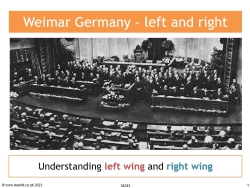Weimar Germany: Understanding left wing and right wing

This complete lesson on the politics of Weimar Germany introduces students to the main German political parties of the Weimar Republic, including their support base and their key members in the 1920s and provides an overview of the political and economic changes in Germany after the First World War. It will also help students to understand the differences between left-wing and right-wing political views more generally and to define key political terms such as 'reform', 'democracy' and 'constitution'.
The German political parties covered in this resource are:
- the German Communist Party (KPD)
- the Social Democratic Party (SPD)
- the Centre Party (Zentrum)
- the German Democratic Party (DDP)
- the German People's Party (DVP)
- the National Socialist German Workers' Party (NSDAP or the Nazis).
The figures referred to are:
- Ernst Thälmann
- Herman Müller
- Ludwig Kass and Heinrich Brüning
- Walther Rathenau
- Gustav Stresemann
- Adolf Hitler.
Students begin by sorting changes into ‘political’ or ‘economic’ and consider the impacts of those changes. They read more detailed information about the abdication of the Kaiser and the creation of the Weimar Constitution and answer comprehension questions. They then complete a table summarising information about the key German political parties and place those parties on a spectrum from left to right, helping them to realise that, despite its name, Hitler’s Nazi Party was not a left-wing party but rather an extremist right-wing party.
Extracts from the information in the PowerPoint:
Revolutionary government took over Bavaria and aimed to create a Bolshevik ‘free state of Bavaria’ – the Räterepublik. This was short-lived, being put down by the army and elements of the Freikorps.
[...]
Due to unrest in the capital, Berlin, this new constitution was written in the town of Weimar and so historians refer to the period 1919-1933 as the ‘Weimar Republic’.
